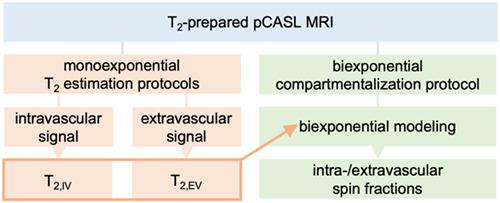当前位置:
X-MOL 学术
›
NMR Biomed.
›
论文详情
Our official English website, www.x-mol.net, welcomes your
feedback! (Note: you will need to create a separate account there.)
Blood-brain barrier permeability measurement by biexponentially modeling whole-brain arterial spin labeling data with multiple T2 -weightings.
NMR in Biomedicine ( IF 2.7 ) Pub Date : 2020-07-26 , DOI: 10.1002/nbm.4374 Martin Schidlowski 1, 2 , Markus Boland 2 , Theodor Rüber 1, 3, 4 , Tony Stöcker 2, 5
NMR in Biomedicine ( IF 2.7 ) Pub Date : 2020-07-26 , DOI: 10.1002/nbm.4374 Martin Schidlowski 1, 2 , Markus Boland 2 , Theodor Rüber 1, 3, 4 , Tony Stöcker 2, 5
Affiliation

|
Blood–brain barrier (BBB) permeability assessment remains of ongoing interest in clinical practice and research. Transitions between intravascular (IV) and extravascular (EV) gray matter (GM) compartments may provide information regarding the microstructural status of the BBB. Due to different transverse relaxation times (T2) of water protons in vessels and GM, it is possible to determine the compartment in which these protons are located. This work presents and investigates the feasibility of a simplified analytical approach for compartmentalizing the proportions of magnetically marked water protons into IV and EV GM components by biexponentially modeling T2‐weighted arterial spin labeling (ASL) data. Numerous model assumptions were used to stabilize the fit and achieve in vivo applicability. Particularly, transverse relaxation times of IV and EV water protons were determined from the analysis of two supporting T2‐weighted ASL measurements, utilizing a monoexponential signal model. This stabilized a two‐parameter biexponential fit of ASL data with T2 preparation (PLD = 0.9/1.2/1.5/1.8 s, TET2Prep = 0/30/40/60/80/120/160 ms), which thereby robustly provided estimates of the IV and EV compartment fractions. Experiments were conducted with three healthy volunteers in a 3 T scanner. Averaged over all subjects, the labeled water protons inherit T2,IV = 200 ± 18 ms initially and adapt T2,EV = 91 ± 2 ms with a longer retention time in cerebral structures. Accordingly, the EVlocated ASL signal fraction rises with increasing PLD from 0.31 ± 0.11 at the shortest PLD of 0.9 s to 0.73 ± 0.02 at the longest PLD of 1.8s. These results indicate a transition of the water protons from IV to EV space. The findings support the potential of biexponential modeling for compartmentalizing ASL spin fractions between IV and EV space. The novel integration of monoexponential parameter estimates stabilizes the two‐compartment model fit, suggesting that this technique is suitable for robustly estimating the BBB permeability in vivo.
中文翻译:

通过使用多个 T2 加权对全脑动脉自旋标记数据进行双指数建模来测量血脑屏障通透性。
血脑屏障 (BBB) 通透性评估在临床实践和研究中仍然受到持续关注。血管内 (IV) 和血管外 (EV) 灰质 (GM) 区室之间的转换可以提供有关 BBB 微观结构状态的信息。由于容器和 GM 中的水质子的横向弛豫时间 ( T 2 )不同,因此可以确定这些质子所在的隔室。这项工作提出并研究了一种简化的分析方法的可行性,该方法通过双指数建模T 2将磁性标记的水质子的比例划分为 IV 和 EV GM 组分加权动脉自旋标记 (ASL) 数据。许多模型假设用于稳定拟合并实现体内适用性。特别是,IV 和 EV 水质子的横向弛豫时间是利用单指数信号模型从两个支持的T 2加权 ASL 测量的分析中确定的。这稳定了具有T 2准备的 ASL 数据的双参数双指数拟合(PLD = 0.9/1.2/1.5/1.8 s,TE T2Prep = 0/30/40/60/80/120/160 ms),从而稳健地提供IV 和 EV 隔室分数的估计。在 3 T 扫描仪中对三名健康志愿者进行了实验。对所有受试者取平均值,标记的水质子继承T 2,IV = 200 ± 18 ms最初并适应T 2,EV = 91 ± 2 ms,在大脑结构中保留时间更长。因此,EVlocated ASL 信号分数随着 PLD 从 0.9 s 最短 PLD 时的 0.31 ± 0.11 增加到 1.8 s 最长 PLD 时的 0.73 ± 0.02 增加。这些结果表明水质子从 IV 空间过渡到 EV 空间。这些发现支持双指数建模在 IV 和 EV 空间之间划分 ASL 自旋分数的潜力。单指数参数估计的新整合稳定了双室模型拟合,表明该技术适用于可靠地估计体内 BBB 通透性。
更新日期:2020-09-03
中文翻译:

通过使用多个 T2 加权对全脑动脉自旋标记数据进行双指数建模来测量血脑屏障通透性。
血脑屏障 (BBB) 通透性评估在临床实践和研究中仍然受到持续关注。血管内 (IV) 和血管外 (EV) 灰质 (GM) 区室之间的转换可以提供有关 BBB 微观结构状态的信息。由于容器和 GM 中的水质子的横向弛豫时间 ( T 2 )不同,因此可以确定这些质子所在的隔室。这项工作提出并研究了一种简化的分析方法的可行性,该方法通过双指数建模T 2将磁性标记的水质子的比例划分为 IV 和 EV GM 组分加权动脉自旋标记 (ASL) 数据。许多模型假设用于稳定拟合并实现体内适用性。特别是,IV 和 EV 水质子的横向弛豫时间是利用单指数信号模型从两个支持的T 2加权 ASL 测量的分析中确定的。这稳定了具有T 2准备的 ASL 数据的双参数双指数拟合(PLD = 0.9/1.2/1.5/1.8 s,TE T2Prep = 0/30/40/60/80/120/160 ms),从而稳健地提供IV 和 EV 隔室分数的估计。在 3 T 扫描仪中对三名健康志愿者进行了实验。对所有受试者取平均值,标记的水质子继承T 2,IV = 200 ± 18 ms最初并适应T 2,EV = 91 ± 2 ms,在大脑结构中保留时间更长。因此,EVlocated ASL 信号分数随着 PLD 从 0.9 s 最短 PLD 时的 0.31 ± 0.11 增加到 1.8 s 最长 PLD 时的 0.73 ± 0.02 增加。这些结果表明水质子从 IV 空间过渡到 EV 空间。这些发现支持双指数建模在 IV 和 EV 空间之间划分 ASL 自旋分数的潜力。单指数参数估计的新整合稳定了双室模型拟合,表明该技术适用于可靠地估计体内 BBB 通透性。









































 京公网安备 11010802027423号
京公网安备 11010802027423号